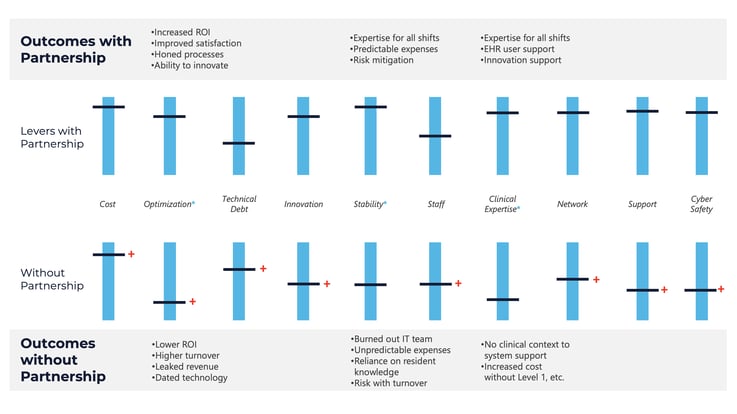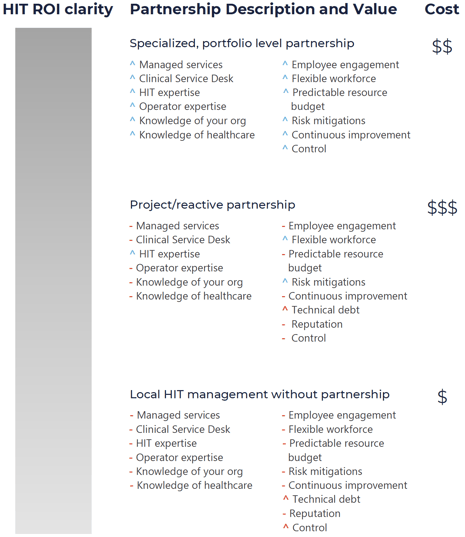

By Phil Sobol | Feb 23, 2024
6 minute read EHR/EMR| Blog| Managed Services| IT Strategy
Technology is a must have for patient and provider experiences, but how do you ensure a return on your healthcare organization’s investment? And how do you prove the return was realized?
As part of your commitment to optimizing technology for maximum ROI, you, like many others, may turn to partners to supplement the core competencies of your team. Partnership is a sound approach. Combining your team’s competencies with those of a partner can be powerful – especially when you partner with a technology firm that specializes in healthcare. And if the firm employs practitioners with experience as hospital operators – that’s even better.
Stronger Strategies are Built on Hospital Operator Experience
Numerous technology services firms offer technical understanding, and that has brought celebrated improvements across industries including healthcare. Fewer information technology partners specialize in healthcare IT (HIT) which focuses on the strategic imperatives, the everyday workflows, the inherent risks, and the untapped opportunities for technology at hospitals and in health systems. All partners should help your organization’s HIT strategy address the pressures of our times and the ones with healthcare experience will help you be more strategic in your approach.
What follows are considerations for health systems determined to realize the top ROI for HIT in their organization through a comprehensive, operator focused partnership that delivers technical expertise and clinical knowledge in defense against some of the greatest challenges facing our industry.
Industry Challenge: Containing IT costs and engaging users – especially providers.
HIT is an important part of driving additional value for healthcare organizations through training, functionality, automation, and more since passing costs on is not an option and neither is increasing the budget. Reimbursements are on the decline and IT budgets are down in 2023 compared to 2022 per Digital Health Most Wired National Trends 2023 Report. Organizations require HIT professionals with direct experience in healthcare to have a better understanding of cost pressures and how to operate without options available to other industries. For instance, in retail, cost pressures are passed on via higher prices for customers. Whereas, in healthcare, declining reimbursement rates create financial pressures and healthcare operators are asked to contain costs and improve services at the lower rate. Healthcare organizations are literally charged with doing more with less.
A Clinical Service Desk Example:
Every technology support organization offers levels of support with increasing expertise. Effective HIT support identifies an increase in volume for an issue, works through the issue and acts (ex: end user training, agent training, etc.) to address that volume since the repetition and lack of knowledge is costly in terms of budget and care team resources. An efficient HIT support organization works from a mature knowledgebase (human and digital, technical and clinical).
Why combine technical and clinical know-how on the service desk?
CereCore’s Clinical Service Desk Early Results
Our clinical service desk offering for facilities on Epic at a major healthcare organization shows early results that are encouraging:
.png?width=730&height=183&name=2.20%20blog%20graphic%20(2).png)
| Director, Jan 2024, KLAS review
| Rick Keller, SVP and CIO at Ardent Health Services, a CereCore IT support services partner
Industry Challenge: Attracting providers, patients, and employees that consider your system “preferred.”
In healthcare, experiences are everything and expectations for technology are high. HIT partners understand the impact of technology changes on users, on infrastructure, on budget, and as a reputation definer for you and your team. A true HIT partner can:
HIT Team Capability Levers: With and Without Partnership

+ = More Costly Over Time
* = CereCore Specialty Area
Industry Challenge: Meeting the new and broad expectations of CIOs and other HIT leaders. As reported by Chief Strategy Officer, Peyman Zand, CIOs are taking on challenges that are no longer limited to the world of IT and are expanding their sphere of influence over staff shortages, operational efficiencies, revenue cycle, and clinical workflow optimization.
Partners with experience in hospital operations are ready to help CIOs set strategy for the uniqueness of each hospital or system’s business model, the services they offer, and how to scale if applicable. Perspective that comes from experience at the largest organizations and with clients that are smaller and not focused on scale defines an organization’s success to date and will be at the heart of their performance in the future.
A Critical Access Hospital Example:
History shows that a critical access hospital’s journey could involve mergers or acquisitions as often as every few years. HIT experts advise a technology path that prepares these hospitals for the transitions of the future with patients and care teams in mind so technology can be as seamless as possible without sacrificing experiences. HIT partners consider more than the implementation or technology project of the moment. Understanding the industry today can set a critical access hospital on the right path for many versions of what tomorrow could bring. For many rural communities, this is an important consideration for their hospital, the resources they can expect, and the ownership scenarios that could be in their future.
A Data Storage Example:
The best HIT partners can manage servers, can move workflows and disaster recovery to the cloud while also identifying ways to optimize. Specialized HIT experts understand access and can map out a storage plan that enables necessary access on servers with appropriate capacity (not too much, not too little) and often contained cost. More general approaches to storage management often include more than necessary storage capacity, and, therefore, more cost for the equipment, temperature control for its environment, hardware compliance management, etc.
Industry challenge: Meeting or exceeding expectations of technology at the speed of healthcare – with compassion. HIT technology professionals choose HIT because they are empathetic and driven to contribute towards a greater cause. Understanding how HIT directly impacts patients and relating to the work as patients or operators themselves, feeds a HIT professional’s drive to improve and innovate. To HIT partners comprised of experts who also empathize, resolving issues for their hospital and health system clients is far more than transactional, and it shows in form of urgency, preparation, and expertise.
A Partner Example:
CereCore clients can rest assured that we are in HIT for the long haul, and this is important in an era that has called for resiliency. Backed by the support of our parent company, HCA Healthcare, and not a venture capital firm or other investor, we can be patient, methodical, and mindful of the beneficiaries of what we do. Patients, providers, care teams, business offices, etc. benefit when their HIT team is focused on patient outcomes and hospital goals rather than sales goals and services that aren’t backed by operator experience, clinical expertise, and the ability to pivot when the unprecedented happens.
A review of the technology industry reveals very few organizations with the consistency and longevity of our parent company. Most potential partners show histories of changing ownership, discontinuing some services, and diluting others. Many technology firms are created with the intent to build for a time then sell for profit. That’s not the case at CereCore. We urge health organizations to choose HIT partners based on the ability to be resilient, and, therefore, consistent for you. Trusting partnership to the firm most closely associated with one of the world’s largest healthcare IDNs is persuasive for decision makers, and for good reason.
Start by committing to specialized HIT
Expectations for IT in healthcare are high. The use cases call for expertise, understanding, and empathy in addition to service level agreements, time to resolution stats, and traditional pricing and contract scoping exercises. Our Healthcare Technology ROI Pillar shows how a specialized partnership focused on your entire technology portfolio is a solid and dependable approach to technology that optimizes, mitigates risk, and provides return on your investment, too.
CereCore’s Healthcare Technology ROI Pillar

- new value opportunity – Characteristics that don’t exist in this partnership scenario, but a different partnership scenario could introduce this characteristic and add new value for your organization.
^value on improvement path – Values that are demonstrated in the indicated partnership scenario and offer continued or improved value over time.
^value deficit – Value opportunities that are not resident in the indicated partnership scenario and become more detrimental to the organization over time.
Return on your healthcare IT investment is most notable when technical and clinical skills are applied to your technology agenda. Installing shiny new technology is one thing, but partnering with experts to apply validated practicality, mitigated risk, optimized workflows, etc., to help ensure return on your organization’s technology investment is how to measurably improve a hospital or health system for all its stakeholders.
Vice President, Business Development, CereCore
Vice President, Business Development, CereCore
Let us know how we can support your initiatives and take some of the heavy lifting from healthcare IT.
© All Rights Reserved CereCore Terms of Service California Notice at Collection Privacy Policy Responsible Disclosure